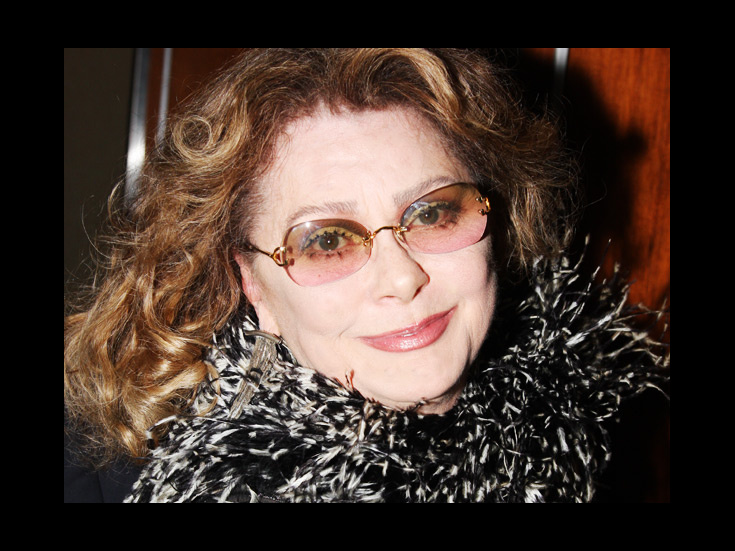The Best Man's Elizabeth Ashley on Seducing Audiences in Barefoot in the Park, Cat on a Hot Tin Roof & More
Elizabeth Ashley is endlessly entertaining in conversation, but don’t let her self-deprecating chitchat fool you: After more than 50 years in the theater, this lady knows plenty about what works on stage and can explain exactly why her talent is suited to the plays of Tennessee Williams and, more recently, Horton Foote. Ashley has just returned to Broadway as Mrs. Sue-Ellen Gamadge (a role she previously played in 2000) in Gore Vidal’s The Best Man, the 1960 political comedy she calls “so far ahead of its time, it becomes more valid every time it’s done.” For her Broadway.com Role Call, Ashley takes us on a fascinating tour of her five decades as a stage star.
 Role That Became a Broadway Phenomenon
Role That Became a Broadway Phenomenon
“The role of [newlywed] Corie in Barefoot in the Park [1963; Best Actress Tony nomination] was written for me. This was before Neil Simon was Neil Simon, and I was the hot young twinkie on Broadway because I had just won a trophy [a Tony Award for Take Her, She’s Mine]. They were talking about casting an actor I didn’t know, [Ashley’s future real-life husband] George Peppard, and I said, ‘What about my buddy Bob Redford?’ It was [director] Mike Nichols’ first Broadway play, and he immediately understood that Bob had a unique take on how to play comedy. Mike Nichols is a genius—he has confidence and taste and intelligence, and he loves actors. I didn’t know what to do with Corie, and Mike said, ‘You’re just a regular girl who does girly things and wants to get married.’ That’s all he needed to say. The play was a huge hit. The morning the reviews came out, the line went up Eighth Avenue and doubled back to the Biltmore Theatre on 47th Street. ‘Doc’ Simon handed out coffee to the people waiting in line.”
 Role I Looked the Best In
Role I Looked the Best In
“The first time I was ever grateful for the way I look was in Cat on a Hot Tin Roof [1974, as Maggie; Best Actress Tony nomination]. I was in my sexual prime: In a world of 10s, I was a 25, and I used it flagrantly because that’s what Maggie does. That’s her weapon. Tennessee [Williams] told me that the role had never been played by a southern woman in a major production. Consequently, I knew the language and the cadencies instinctively. It’s not slow, which is the classic mistake; it’s rapid fire, and in waltz time. It’s rare to get a part where everything in your life has conspired to make you that hungry and that savage. Cat on a Hot Tin Roof resurrected my career. I had a Broadway career and then a movie career, and then I had a full-on brain fuck and married a movie star [George Peppard] and retired. There is nothing deader in this business than a movie star’s wife. At the time I got this play, I was desperate because I didn’t think I would ever get the opportunity to do work of any consequence again.”
 Role That Fit Me Like a Glove
Role That Fit Me Like a Glove
“Sweet Bird of Youth [1998, as Alexandra del Lago] is other part that I felt I owned. I love this woman because she never lies, by omission or commission. She has no illusions or delusions, and you can’t say that about most characters. I did it at the Shakespeare Theatre in DC with the great Michael Hayden playing Chance Wayne. It was a wonderful production, maybe the best production of that play ever done. We had a huge cast, the kind of thing they couldn’t afford to do on Broadway, and Michael Kahn, who also directed Cat on a Hot Tin Roof, found the most incredible script. Like a lot of Tennessee’s plays, there are many versions of Sweet Bird out there; the published version that was done on Broadway with Geraldine Page had a lot of things that are wrong. It was just a great experience all around. Marty Pakledinaz did my costumes, and Paul Huntley did wigs that were works of art.”
 Role That Was the Most Fierce
Role That Was the Most Fierce
“Sometimes one line tells you so much about a character. In the case of Regina in The Little Foxes [2002, Shakespeare Theatre in Washington DC], that line is, ‘I hope you die!’ She doesn’t just think something like that about the man she lives with, she says it. Regina will do anything in fighting for her inheritance and her place in this patriarchal family; everything is in her husband’s name or her brothers’ name. I love doing research about the period a play is set in, and I read the wonderful author Diane McWhorter’s book Carry Me Home. Some horrific things came out of Birmingham, and that tells you a lot about the era Lillian Hellman [whose mother was from a prominent Alabama banking family] is writing about.”
 Role That Was the Hardest
Role That Was the Hardest
“My most challenging show was Zerline’s Tale [2008], a play I did at Hartford Stage specifically for [the late Shubert chairman] Gerry Schoenfeld. An obscure Austrian wrote a novella that got translated into French, and Jeanne Moreau had a huge success with it in Paris. For some reason, Gerry, who did not speak French, always wanted to do this play and got a translation done [by playwright Jeremy Sams]. The role was an old woman in a house in the countryside in Germany between the world wars. A man is sitting in a room, and she comes in with a bucket of coal and proceeds to tell him her life story. It was pretty much a one-woman show, and the character was wicked and sly and clever and mysterious and dangerous. It was very hard, but I loved it.”
 Role That Was the Most Fun
Role That Was the Most Fun
“Stella Gordon, the matriarch in Horton Foote’s Dividing the Estate [2007, off-Broadway; 2008, Broadway], was a great character. Western cultures tend to marginalize old women and portray them as fools or monsters. I think old women frighten people because we hold the secrets of the world: We know exactly how big your dicks are because we gave birth to you and changed your diaper. I have never allowed myself to be pushed into playing a grosteque older woman. Stella was a matriarch who doesn’t put on any kind of public face. She was funny and cranky and contradictory, but also a paragon of dignity and integrity, and very vulnerable when it came to her relationship with her ne'er-do-well son. It was wonderful to play the emotional journey of a woman at that stage of life.”
 Elizabeth Ashley
Elizabeth AshleyPhoto by Bruce Glikas

